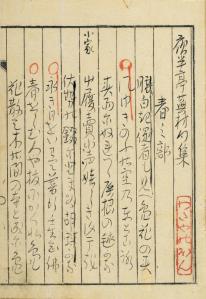(Hailstone Exhibition Visit and Ginko, Dec. 3, 2022: report by Jun Tsutsumi & Stephen Gill)
野ざらし紀行図巻 The Nozarashi Kikō Zukan, “Records of a Weather-exposed Skeleton,” Basho’s scroll of the first of his great haibun journeys made in 1684-5, is the only one known with both paintings and calligraphy from the master poet’s brush. A year or so ago the rare scroll had come to light for the first time in more than half a century. It is a startling piece of work.

Click respective photos to enlarge. 上 Narutaki in Kyoto (pagoda of Ninnaji vis. top lt.), 下 Potato-washing woman at Yoshino (Yoshimizu Jinja vis. on lt.)
Bright autumn leaves
through the train window –
getting drunk on them! … (Harumi)
On a crisp December morning, fifteen Hailstone poets gathered to view the scroll at the Fukuda Museum of Art. Even as the streets near Arashiyama station were already dense with late-autumn crowds, the 14-meter scroll was mostly ours to enjoy alone in the quiet of the exhibition room.
After fifty years wandering,
‘The Weather-exposed Skeleton’
at home in autumn hills … (Ayako)
Basho’s beautiful calligraphy and paintings took us with him on his journey from Edo to his hometown of Iga Ueno; and, thereafter, around the area of Japan that we know best, Kansai. The sensibility of his paintings of some of the places he visited added a new dimension to his well-known haibun itself and the poems it contains.
明けぼのやしら魚しろきこと一寸Akebono ya / shirauo shiroki / koto issun
Before sunrise…
young icefish flashing white,
each but one inch long … (Basho, trans. SHG)
The exhibition also featured works by Yosa Buson and Ito Jakuchu, which made for an abundant morning of art.
Inviting me to view
Basho’s ‘Bleached Bones’ travelogue,
‘Two Skulls’ by Jakuchu … (Akishige)
We walked out into gentle sunlight just after noon. Some of us enjoyed lunch together at the nearby Nakagawa restaurant, while others departed on errands or for home.
Hot rod cars
rev at the bridge –
a tinted Mt. Atago … (Tito)
a stretch of tourists
along the riverbank
autumn colors … (Duro*)
We reunited at the southern end of Togetsu Bridge for a haiku composition stroll (ginko) along the winding riverside path leading past Tonase Cascade all the way up to 大悲閣千光寺Daihikaku Senkōji Temple. The clear skies and gentle light cast the hills in rich hues, with views of Mt. Atago, Mt. Ogura, the Saga Hills, and even distant Mt. Hiei beyond the still waters of the Ōi River, dotted with rowboats.
tracing in my mind
the lines of Basho’s brush:
our riverside stroll … (Jun)
Winter calm –
on this water they know so well
here and there, wild ducks … (Masahiro*)
Our Basho Day feeling
more like a year:
floating into a trench
coloured leaves … (Tomiko)
The crowds receded further and further into the distance as we approached the steps leading up to the Temple, which Basho had once visited.
花の山 二町ぼれば 大悲閣 Hana no yama / nichō noboreba / Daihikaku
Two hundred yards
up a mountainside of blooming cherry…
Great Mercy Temple … (Basho, trans. SHG)
There is a kuhi (poem monument) near the beginning of the climb.
Basho’s stele –
red maple seekers, beckoned
to worn stone steps … (Akihiko)
Those who made it up to the temple itself, were able to pray before the ancient Kannon statue, then view another (much wilder!) one of 角倉了以 Suminokura Ryoi, the ‘Renaissance man’ who had set up a trading network in Southeast Asia for Toyotomi Hideyoshi as well as creating navigable waterways in and around Kyoto, and who had spent his last days here as a recluse.
A monk with a broom …
trying hard not to sweep up too
the late afternoon moon … (Tito)
The view back over the city was spectacular, as were the fading late autumn colours. Someone rang the temple bell.
Arashiyama –
your perfect autumn tints
now, as long ago … (Hiroko)
the wharf at dusk –
autumn pleasure-seekers’ backs
file away … (Akihiko)
Basho’s journey
continues into dream –
my warm futon … (Yaeno)
N.B. The Exhibition finishes at the Fukuda Museum on 9 Jan. 2023; the painting of Basho below is in the Exhibition and is by Yosa Buson; Duro & Masahiro sent their haiku in later and were not actually present at the event.


























